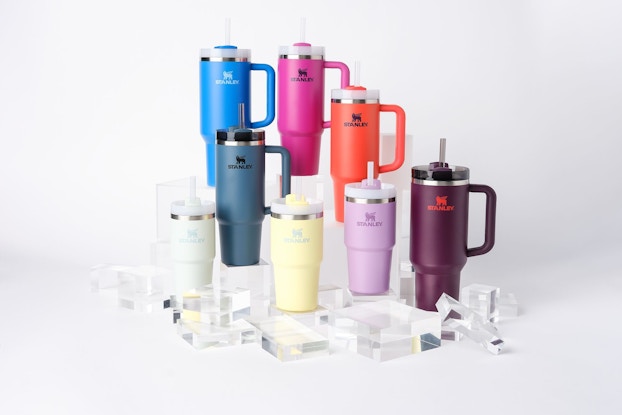
Experts on 3 ways Stanley turned a utilitarian water bottle into one of the hottest selling ‘affordable luxury’ items beloved by millennials:
- The 113-year-old Stanley brand brought newfound fashion appeal to its water bottles by adding trendy colors and finishes to its product mix — key to drawing women and the ‘influencer crowd,’ while also benefiting from its authentic, construction-worker roots, said Ross Steinman PhD, Professor at Widener University.
- The brand created marketing buzz for its tumblers via exclusive limited-edition collections with celebrities such as country singer Lainey Wilson, Target, and Starbucks, just as videos on TikTok of Stanley fans using — and clamoring for —the product made it ‘relevant to the cultural zeitgeist,’ said Oliver Chen, Managing Director, Retail, Luxury, New Platforms Sector Head, TD Cowen.
- Stanley’s tumblers also capitalized on two key trends: wellness and sustainability. Reusable water bottles ‘have been ubiquitous for a few years,’ said Mark Cohen, Director of Retail Studies at Columbia Business School. ‘And it carries with it this attractive environmental appeal.’
How did an industrial-sized tumbler, favored by steelworkers and birthed during president Woodrow Wilson’s administration, capture the rabid devotion and dollars of fashion-conscious millennials and Gen Z?
The 113-year-old Stanley drinkware brand fueled a sales surge from $70 million to $750 million in four years by building a grassroots following among women. It culled from Crocs’ fashion-forward footwear brand-revival strategy by hiring the very architect of that strategy. And at the same time, Stanley’s reusable water bottles tapped into powerful converging trends: the $450 billion U.S. wellness economy, the sustainable movement, and consumers’ timeworn affection for brands that bear the hard-won ring of authenticity, experts told CO—.
“Stanley was the thermos inside the metal lunchbox with the bologna sandwich and apple of that guy in the steel mill,” said Mark Cohen, Director of Retail Studies at Columbia Business School, and the former CEO of Sears Canada. “And now it has become the must-have item on the part of younger people because it’s authentic,” he said. The brand’s newfound success reflects a “magical intersection of opportunities.”
Here, analysts unpack how Stanley maximized those opportunities to transform a utilitarian product into one of the fastest-growing affordable luxury brands today, with implicit lessons for businesses large and small.
The Crocs effect: Exec from hot clog brand brings marketing playbook to Stanley
Stanley’s mature-business-gains-newfound status draws from Crocs’ playbook, the utilitarian rubber clogs worn by healthcare workers turned fashion must-have.
In 2020, the water bottle and thermos brand hired Terry Reilly, who helped nudge Crocs’ style ascent, to be its president.
Under his leadership, Stanley’s 40-ounce Quencher became its hero item, turning up in a wide array of colors and finishes like Rose Quartz and Soft Matte Stormy Sea amid the brand’s courtship of women, an untapped market.
Just as Crocs’ collaborated with Balenciaga to Justin Bieber, the Quencher dropped limited-edition items with partners ranging from Starbucks and Target to country singer Lainey Wilson, viral sellers that helped burnish its cool factor, too.
Stanley is both serving and embracing new markets via these partnerships, Oliver Chen, Managing Director, Retail, Luxury, New Platforms Sector Head, for investment bank TD Cowen, told CO—. Via its Target collaboration, for one, Stanley is reaching the mom shopper, while teaming with a retailer known for “accessible style,” he said. Indeed, “One of the premises of Target’s [business model] is ‘Design for All.’”
[Read: Trend Forecasters on Four Key Consumer Trends Set to Impact Business in 2024]
Stanley was the thermos inside the metal lunchbox with the bologna sandwich and apple of that guy in the steel mill. And now it has become the must-have item on the part of younger people because it’s authentic.
Mark Cohen, Director of Retail Studies, Columbia Business School
Stanley cups tap into a fount of brand authenticity: ‘Many brands are learning that industrial-grade products appeal to unexpected consumer segments’
Stanley’s success follows in the tradition of functional brands with industrial and commercial roots that enjoy robust consumer-market appeal, in part for their authenticity. Stanley recognized that and tapped into it, analysts said.
The lure of Stanley cups’ rugged construction-worker legacy mirrors Crocs’ durable foam resin, dock-worker appeal, and Carhartt or Timberland’s built-to-last clothing and boots — products geared toward “blue-collar, trade-based professionals; items that are extremely durable and do not have to be replaced frequently,” Ross Steinman PhD, Professor at Widener University, told CO—.
“Many brands are learning that industrial-grade products appeal to unexpected consumer segments,” including the categories of fashionable workwear and residential kitchen appliances, among others, he said. “Today’s consumers crave authenticity, and these products have been pilot tested by a trustworthy group who are using the objects in demanding conditions, much beyond the scope of how the average person will deploy them,” Steinman said. Now, Stanley’s “indestructible and indispensable product has made its way to the influencer and micro-influencer crowd.”
[Read: Retro Rewards: How Businesses Are Monetizing the Nostalgia Trend to Win Over New Customers]
Stanley’s ‘quiet luxury’ success formula: Putting a fresh spin on a heritage brand with built-in wellness cred — and a little help from TikTok
Harnessing its built-in authenticity, Stanley added a layer of fashion and marketing innovation to transform the cup into a bona fide “it” item, with a little help from TikTok.
Indeed, videos of Stanley devotees unboxing their bottles and swarming retail aisles to score a Quencher have racked up millions of views on the app, helping to send the company’s sales and brand equity through the roof. “The short-form videos have been extremely important to building demand via user-generated content,” TD Cowen’s Chen said.
As a result, it’s become an affordable status symbol, reflecting the “quiet-luxury trend,” he said. The trend is “rooted in consumer preferences for craftmanship, fine materials, heritage design and brand stories, and understated looks,” according to a Cowen report, “a counterbalancing force to logos and signature prints.”
The rise of the Stanley H2.0 tumbler is also a case study on how to tie marketing innovation to a big lifestyle trend—in this case, health and wellness, which is now a $450 billion industry in the U.S., of which water consumption is a part.
“It’s a product that coincides with a trend by way of usage,” said Columbia’s Cohen. Reusable water bottles “have been ubiquitous for a few years. And it carries with it this attractive environmental appeal. It’s water bottle as fashion accessory.”
The result is a heritage brand that’s been updated to be “relevant to the cultural zeitgeist,” Cowen said. The Stanley cups are “creating a community—it’s a badge.”
In the end, “We are tribes of people that like to be surrounded by brands, emblems, totems — things that give us comfort,” said Cohen.
CO— aims to bring you inspiration from leading respected experts. However, before making any business decision, you should consult a professional who can advise you based on your individual situation.
CO—is committed to helping you start, run and grow your small business. Learn more about the benefits of small business membership in the U.S. Chamber of Commerce, here.








